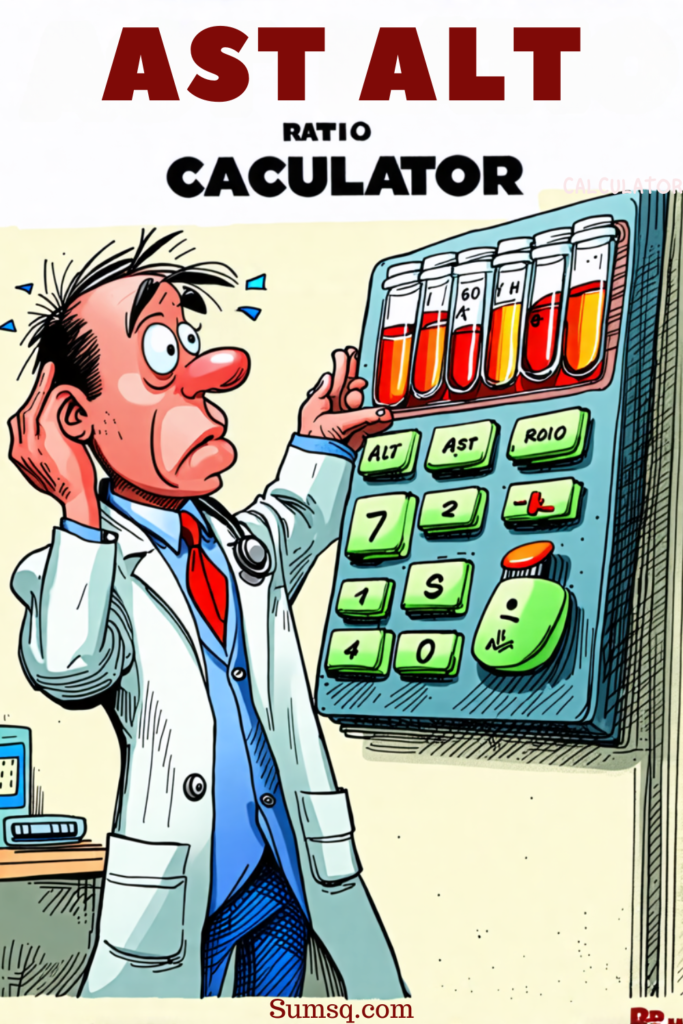AST ALT Ratio Calculator
This AST ALT ratio calculator helps you calculate the ALT to AST ratio and helps you determine whether it is in the normal range, too high, or too low.
Enter your AST and ALT to calculate the ratio.
If you don’t know, AST stands for aspartate aminotransferase, and ALT stands for Alanine transaminase.
The ALT and AST ratio is helpful in fatty live cases.
- The normal ratio of AST to ALT should be 1.
- If the AST: ALT ratio exceeds 1, the person has alcoholic liver disease.
- If the AST: ALT ratio is 1, it indicates NAFLD/NASH, where the liver accumulates excessive fat deposits.

You might be interested in finding arterial pressure or coma severity.
The AST/ALT ratio calculator is an essential medical calculator used in the diagnosis and evaluation of various liver diseases. This tool helps healthcare professionals interpret the relationship between two important liver enzymes: aspartate aminotransferase (AST) and alanine aminotransferase (ALT). By calculating the ratio of these enzymes, medical practitioners can gain valuable insights into liver health and potential liver damage.
What are AST and ALT?
Before getting into the details of the AST/ALT ratio calculator, it’s crucial to understand what these enzymes are and their significance in liver function.
Aspartate Aminotransferase (AST)
AST is an enzyme found in various tissues throughout the body, including the liver, heart, muscles, and kidneys. While it’s not specific to the liver, elevated levels of AST in the blood can indicate liver damage or disease. AST is released into the bloodstream when liver cells are injured or die.
Alanine Aminotransferase (ALT)
ALT is an enzyme primarily found in the liver. It’s more specific to liver function than AST, making it a more reliable indicator of liver health. Elevated ALT levels in the blood typically suggest liver damage or disease.
The Importance of the AST/ALT Ratio
The AST/ALT ratio, also known as the De Ritis ratio, is a valuable tool in assessing liver health and diagnosing various liver diseases. This ratio helps healthcare providers distinguish between different types of liver damage and can provide insights into the underlying cause of liver dysfunction.
Normal AST/ALT Ratio
In healthy individuals, the AST/ALT ratio is typically less than 1, meaning that ALT levels are higher than AST levels. A normal AST/ALT ratio ranges from 0.7 to 1.0. However, it’s important to note that the interpretation of this ratio should always be done in conjunction with other clinical findings and laboratory tests.
Interpreting Elevated AST/ALT Ratios
An elevated AST/ALT ratio (greater than 1) can be indicative of various liver conditions:
- AST/ALT ratio > 2: This is often associated with alcoholic liver disease or cirrhosis.
- AST/ALT ratio between 1 and 2: This may suggest viral hepatitis or nonalcoholic fatty liver disease (NAFLD).
- AST/ALT ratio < 1: While this is considered normal, it can also be seen in some cases of NAFLD or acute viral hepatitis.
How to Use the AST/ALT Ratio Calculator
Using the AST/ALT ratio calculator is straightforward. Follow these steps:
- Enter the AST value in U/liter (Units per liter).
- Enter the ALT value in U/liter.
- Click the “Calculate” button.
- The calculator will display the AST/ALT ratio and provide a basic interpretation.
It’s important to remember that while this calculator can provide valuable information, it should not be used as a sole diagnostic tool. Always consult with a healthcare professional for proper interpretation and diagnosis.
Clinical Applications of the AST/ALT Ratio
The AST/ALT ratio calculator has several important clinical applications in the diagnosis and management of liver diseases:
1. Alcoholic Liver Disease
In alcoholic liver disease, AST levels are typically higher than ALT levels, resulting in an AST/ALT ratio greater than 2. This elevated ratio is often seen in patients with alcoholic hepatitis or cirrhosis due to chronic alcohol abuse.
2. Nonalcoholic Fatty Liver Disease (NAFLD)
NAFLD is characterized by an accumulation of fat in the liver cells of people who drink little or no alcohol. In NAFLD, the AST/ALT ratio is usually less than 1, with ALT levels being higher than AST levels.
3. Viral Hepatitis
In acute viral hepatitis, such as hepatitis A or B, ALT levels are typically higher than AST levels, resulting in an AST/ALT ratio less than 1. However, as the disease progresses to chronic hepatitis, the ratio may increase.
4. Cirrhosis
Advanced liver disease or cirrhosis often results in an AST/ALT ratio greater than 1, and in many cases, greater than 2. This is due to the more rapid clearance of ALT from the bloodstream in cirrhotic patients.
Limitations of the AST/ALT Ratio Calculator
While the AST/ALT ratio calculator is a useful tool, it’s important to be aware of its limitations:
- Non-specific indicators: Both AST and ALT are not exclusively produced by the liver. Elevated levels can also be caused by conditions affecting other organs, such as the heart or muscles.
- Individual variations: Normal enzyme levels can vary based on factors such as age, gender, and body mass index (BMI).
- Incomplete picture: The AST/ALT ratio alone cannot provide a definitive diagnosis. It should be used in conjunction with other clinical findings and diagnostic tests.
- Timing considerations: The ratio can change over time, especially in acute liver injuries. Serial measurements may be necessary for accurate interpretation.
Other Important Liver Function Tests
While the AST/ALT ratio is valuable, it’s often used alongside other liver function tests for a more comprehensive assessment of liver health:
1. Alkaline Phosphatase (ALP)
ALP is an enzyme found in various tissues, including the liver and bones. Elevated levels can indicate liver disease, particularly those affecting the bile ducts.
2. Gamma-Glutamyl Transferase (GGT)
GGT is an enzyme primarily found in the liver. Elevated levels are often associated with alcohol consumption and can help in diagnosing alcoholic liver disease.
3. Bilirubin
Bilirubin is a yellowish pigment produced when red blood cells break down. Elevated levels can indicate liver dysfunction or bile duct obstruction.
4. Albumin
Albumin is a protein produced by the liver. Low levels can suggest advanced liver disease or malnutrition.
5. Prothrombin Time (PT) and International Normalized Ratio (INR)
These tests measure the blood’s ability to clot and can indicate liver dysfunction, as the liver produces many clotting factors.
Advanced Liver Disease Assessment Tools
For more comprehensive evaluation of liver disease, healthcare providers may use additional tools that incorporate the AST/ALT ratio along with other parameters:
1. APRI (AST to Platelet Ratio Index)
The APRI is a simple index for estimating liver fibrosis. It uses the AST level and platelet count to assess the likelihood of significant fibrosis or cirrhosis.
2. FIB-4 Index
The FIB-4 index combines age, AST, ALT, and platelet count to assess liver fibrosis, particularly in patients with chronic hepatitis C virus infection.
3. MELD Score (Model for End-Stage Liver Disease)
The MELD score is used to assess the severity of chronic liver disease and predict survival. It incorporates serum bilirubin, serum creatinine, and INR.

References
- Nyblom, H., Björnsson, E., Simrén, M., Aldenborg, F., Almer, S., & Olsson, R. (2006). The AST/ALT ratio as an indicator of cirrhosis in patients with PBC. Liver International, 26(7), 840-845.
- Giannini, E., Botta, F., Fasoli, A., Ceppa, P., Risso, D., Lantieri, P. B., … & Testa, R. (1999). Progressive liver functional impairment is associated with an increase in AST/ALT ratio. Digestive diseases and sciences, 44, 1249-1253.
- Hall, P., & Cash, J. (2012). What is the real function of the liver ‘function’tests?. The Ulster medical journal, 81(1), 30.
- Michelotti, G. A., Machado, M. V., & Diehl, A. M. (2013). NAFLD, NASH and liver cancer. Nature reviews Gastroenterology & hepatology, 10(11), 656-665.





